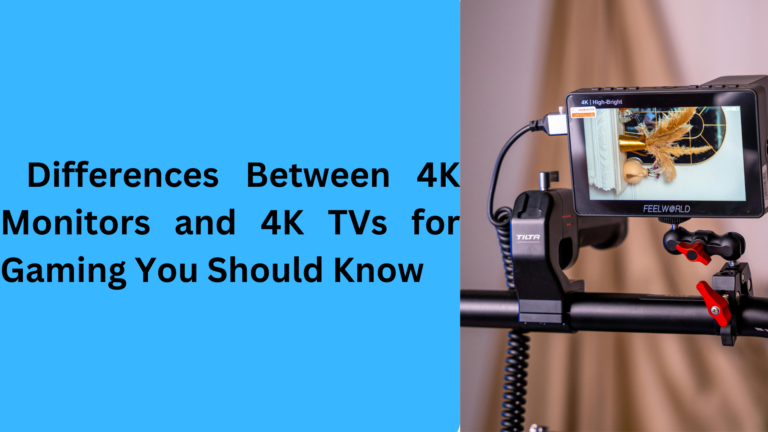10 Key Differences Between Acer and Dell Monitors: What You Need to Know
Choosing the right monitor for your setup can be confusing, especially when two big names, Acer and Dell, are involved. Whether you’re looking for a new gaming monitor, a display for work, or something that offers the best of both worlds, it’s essential to understand how these two brands differ. Here are 5 important differences between Acer vs Dell monitors that can help you decide which is the right fit for you.
1. Build Quality and Design: Comparing Acer and Dell Monitors for Longevity and Style
When it comes to build quality, both Acer and Dell offer durable monitors, but the design philosophy differs. Dell monitors often feature sleek, minimalist designs with ultra-thin bezels that make them popular for office setups and multi-monitor configurations. Their adjustable stands offer flexibility in height, tilt, and swivel, which is great for ergonomics. On the other hand, Acer monitors tend to focus more on gaming aesthetics, with some models sporting bold designs, RGB lighting, and aggressive styling that appeals to gamers.
If you’re looking for a work-from-home monitor that blends into a professional environment, a Dell ultrasharp monitor might suit your needs better. For those building a gaming rig, Acer Predator or Nitro series could provide the edge in style you’re after.
2. Performance and Display Quality: Is Acer or Dell Better for High-Quality Visuals?
When comparing performance and display quality, both brands offer excellent monitors, but they cater to slightly different audiences. Dell monitors, especially from their UltraSharp series, are known for color accuracy and are highly recommended for content creators, graphic designers, and photographers who need IPS panels with sRGB or AdobeRGB color spaces. Dell excels in offering 4K monitors and high-resolution displays for precision work.
Acer monitors, particularly those in the gaming sector, focus on features like higher refresh rates, low response times, and adaptive sync technologies like NVIDIA G-Sync and AMD FreeSync. This makes them ideal for competitive gaming. If you need a monitor for FPS gaming or fast-paced action games, an Acer monitor with 144Hz refresh rate or even 240Hz will provide a smoother experience compared to Dell’s more professional-oriented screens.
3. Price Comparison: Affordable Acer Monitors vs Premium Dell Displays
One of the most significant differences between Acer vs Dell monitors is the price range. Generally, Acer monitors are known for their budget-friendly options. Whether you’re looking for a 1080p monitor, a QHD display, or an entry-level gaming monitor, Acer has something for almost every budget.
Dell, on the other hand, positions itself more in the mid-range to premium market, especially for their professional-grade monitors. If you’re looking for value for money in the long term and need a monitor for productivity or video editing, investing in a Dell UltraSharp monitor might be worth the higher cost.
4. Gaming Features and Technologies: Acer Gaming Monitors vs Dell Monitors for Gamers
For gaming, Acer has a clear edge with its dedicated Predator and Nitro series designed specifically for gamers. Acer Predator monitors are packed with features like 1ms response times, 240Hz refresh rates, and G-Sync compatibility, making them perfect for gamers looking for top-tier performance.
While Dell does offer gaming monitors, like the Dell Alienware series, their range is smaller compared to Acer. If you’re a casual gamer or need a monitor that can handle both work and light gaming, Dell has a few options that balance both needs. However, if hardcore gaming is your priority, Acer’s lineup provides more options at varying price points, with gaming-centric features.
5. Customer Support and Warranty: Dell’s Reliable Support vs Acer’s Global Reach
In terms of customer support and warranty, Dell is often considered the superior choice. Dell monitors come with excellent after-sales service, including on-site support and extended warranties for their premium models. Dell’s customer service is praised for being reliable and efficient, especially for business users who can’t afford downtime.
Acer also offers a decent warranty and global support, but reviews suggest their customer service can be hit or miss depending on the region. If long-term support and reliability are key factors for your decision, Dell’s established reputation in the customer service space might give them an advantage over Acer.
6. Resolution Options: 1080p, QHD, or 4K – Which Brand Excels?
When it comes to resolution options, both Acer and Dell offer monitors catering to different user needs, but their focus varies slightly. Dell monitors, particularly their professional UltraSharp series, prioritize higher resolutions, such as 4K and 5K displays, making them ideal for tasks like video editing, CAD design, and productivity workflows. These monitors typically come with factory-calibrated color settings and HDR capabilities.
On the other hand, Acer monitors shine in the mid-range 1080p and QHD (1440p) categories, which are favored by gamers and general users. Acer’s 4K monitors are also available but tend to target gamers or multimedia enthusiasts rather than professionals. If you’re looking for value in a 1440p monitor, Acer might offer more affordable options compared to Dell, which leans toward premium features.
7. Panel Technology: IPS, VA, and TN – Which Brand Offers the Best?
Both Acer and Dell use a variety of panel technologies in their monitors, but they serve slightly different audiences. Dell monitors are widely praised for their IPS panels, which provide excellent color accuracy, wide viewing angles, and uniform brightness. This makes them perfect for tasks like graphic design, photo editing, and professional use.
Acer, on the other hand, offers more TN panels in its gaming monitors, which boast ultra-fast response times and low input lag. Acer also has a strong selection of VA panels, which provide deep blacks and high contrast, catering to users who enjoy immersive visuals, such as movie enthusiasts or casual gamers.
If you’re considering IPS vs TN vs VA panels, Dell’s IPS technology is unmatched for professional color work, while Acer’s TN and VA panels are more geared toward gamers and multimedia users.
8. Energy Efficiency and Power Consumption: Eco-Friendly Features Comparison
For users who care about energy efficiency and reducing power consumption, Dell monitors are often the better choice. Dell incorporates eco-friendly features like Energy Star certification, PowerNap, and TCO certification, making their monitors more environmentally conscious. These features also help businesses save on energy costs when using multi-monitor setups.
Acer has made strides in this area, but its focus is often on performance over efficiency. While Acer does offer power-saving modes, they are not as robust as Dell’s features. If you’re looking for a monitor that balances performance with energy efficiency, especially for long hours of use, Dell is the more eco-conscious option.
9. Connectivity Options: Comparing Ports on Acer vs Dell Monitors
When choosing a monitor, connectivity options are crucial for ensuring compatibility with your devices. Dell monitors tend to offer a more comprehensive array of ports, including HDMI, DisplayPort, USB-C, and multiple USB-A ports. USB-C connectivity, in particular, is a standout feature in Dell’s professional models, as it allows for power delivery, data transfer, and video output via a single cable—ideal for modern workstations and laptops.
Acer monitors, while still offering the basics like HDMI and DisplayPort, may lack the extensive USB-C support found in Dell models. However, many of Acer’s gaming monitors include extra HDMI ports for easy connectivity with consoles like PlayStation or Xbox, making them more gamer-friendly.
If you’re prioritizing USB-C monitors for productivity or need multiple connectivity options, Dell monitors might offer better compatibility.
10. Brand Reputation and User Reviews: Trust in Acer vs Dell Monitors
Lastly, the overall brand reputation and user reviews can play a key role in your decision. Dell has built a strong reputation for reliability, especially in the business and professional sectors, where their monitors are trusted for long-term use. Their customer satisfaction ratings and after-sales support are consistently high.
Acer, while highly respected in the gaming industry, occasionally receives mixed feedback regarding build quality in their entry-level models. However, their Predator and Nitro series have earned glowing reviews from the gaming community for their performance and affordability.
If you’re someone who values brand reliability and trustworthiness, Dell’s reputation as a premium professional brand might sway your decision. On the other hand, Acer’s gamer-friendly pricing and performance features could be a game-changer for budget-conscious users.
FAQs: Acer vs Dell Monitors
1. Which is better for gaming: Acer or Dell monitors?
If you’re looking for a gaming monitor, Acer generally outshines Dell due to its high refresh rates, low response times, and features like G-Sync and FreeSync compatibility. The Acer Predator and Nitro series monitors are designed specifically for gamers, offering 144Hz, 240Hz, or higher refresh rates and 1ms response times. Dell also has gaming options, such as the Alienware series, but Acer provides more variety at competitive prices.
2. Are Dell monitors better for professional work and productivity?
Yes, Dell UltraSharp monitors are often preferred for professional use like photo editing, graphic design, and office work due to their color accuracy, IPS panels, and ergonomic designs. Dell monitors also frequently feature USB-C connectivity, making them ideal for modern workstations or dual-monitor setups. If you need a 4K monitor for professional tasks, Dell’s reputation for quality makes it a reliable choice.
3. What are the main differences between Acer and Dell monitors in terms of price?
Acer monitors are generally more affordable, offering budget-friendly options for 1080p and QHD gaming monitors, while Dell leans toward mid-range to premium monitors for professionals and businesses. For instance, Acer provides value-for-money gaming monitors with high refresh rates, whereas Dell’s 4K monitors and UltraSharp series cater to users who are willing to pay more for superior color accuracy and build quality.
4. Do Acer or Dell monitors have better warranty and customer support?
Dell monitors often come with excellent warranties, including on-site support and extended coverage for their high-end models. Dell’s customer service is highly rated, especially for businesses. Acer monitors, while offering global support, can vary in after-sales service quality depending on your location. If reliable warranty and customer support are a priority, Dell is generally considered the better option.
5. Which monitor brand is better for multi-purpose use: Acer or Dell?
If you need a monitor for both gaming and productivity, it depends on your priorities. Acer gaming monitors like the Nitro series provide high performance at a reasonable price, making them great for casual work and serious gaming. However, if you prioritize color accuracy and connectivity for work, Dell’s UltraSharp series or P-Series monitors offer a balanced solution for office use, photo editing, and casual gaming.



